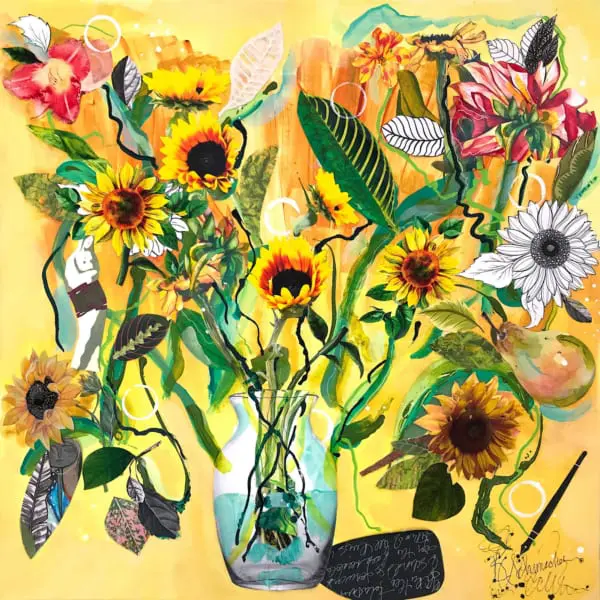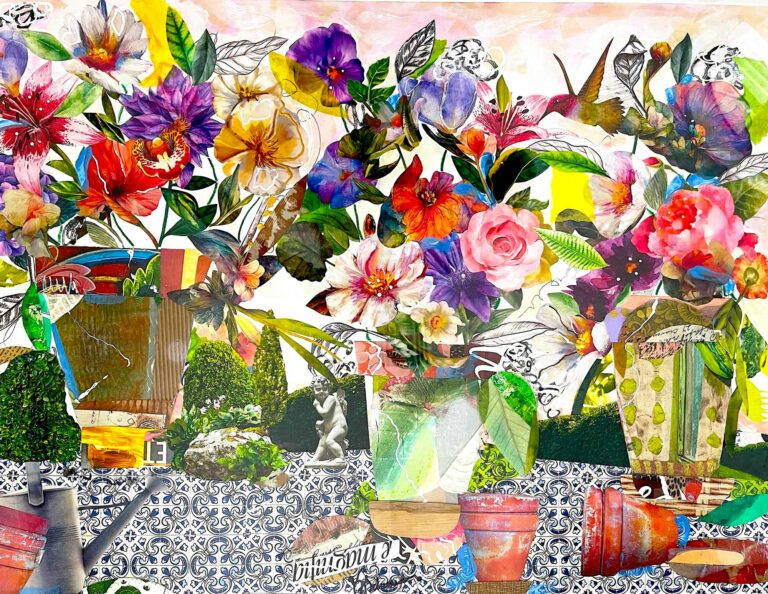As I See It With Bruce Helander – Considering Collage
Like her fascinating flower collages, Kathryn Adele Schumacher’s work is blossoming into handsome, sophisticated compositions made of torn and cut paper from the printed page, which have an unforgettable appeal.
As with most motivated artists I know, Ms. Schumacher became enamored with creative projects by age five as she dabbled in finger paints and realized that this satisfying activity was a bellwether for serious artistic pursuits in her future. Her natural attraction to creativity continued throughout her childhood and ultimately would prompt her to major in fine art and art history in college. These two academic concentrations would stay with the artist as her career continued to develop and mature, leading to an exciting focus on expressing her imagination by utilizing the esteemed ritual of collage.
Ms. Schumacher has always admired the French Impressionists—particularly the Fauves and the Nabis—who worked in abstract realism primarily with color but also with texture and line. She also discovered that many of her inspirations and influences had a relationship with the collage practice, particularly with the connection to abstract impressionism that could manifest itself in the manipulation of adaptively reused paper.
Schumacher also greatly appreciates the genius of Pablo Picasso, particularly his inventive and pioneering technique of applying paper to a painted canvas and his assemblage of disparate materials. The word “collage” comes from “colle,” the French word for glue, and this type of art-making developed into an original concept and style that is closely associated with the beginnings of modern art.
The technique was first invented by Braque and Picasso, who experimented with the concept that painting could be delightfully accented with non-conventional unusual items such as newspapers or magazines. The thought that an oil painting could be somehow “diluted” with the deliberate placement of foreign objects on its surface was a revolutionary idea. Initially, it caused quite an uproar in the arts community.
From its roots in European Dadaism in the early years of the twentieth century, shadowing modernism and tracing its way through photography, collage became a respected medium as diverse and distinguished as traditional fine art categories. Emerging as a reaction to the First World War, collage allowed artists to interact with existing resources, from any published page to maps, tickets, and photographs that could be torn apart and cut into sections and then reassembled, creating visually dynamic hybrids.
According to British critic Anthony Haden-Guest, artists experimenting in Paris in the early nineteen hundreds were the first to incorporate collage into fine art. However, collage received widespread attention years earlier as genteel hobbyism, initiated by Victorian ladies gluing clippings from fashion publications onto screens and other surfaces. Later, as collage entered the mainstream of modern art, it opened up an entirely new medium to examine and with which to experiment. Picasso used chair caning, fake wood grain, and newsprint, while others used labels and newspaper segments to anchor artworks in the real world.
Kurt Schwitters used train tickets, gas bills, playing cards, cloakroom checks, and an array of detritus picked up on the street. Max Ernst, a friend of both Picasso and Braque, illustrated his 1934 novel, Une Semaine de Bonté (A Week of Kindness), with 182 collages made by cutting up plates in Victorian encyclopedias and journals and rearranging the constituent parts into an exotic dreamscape. Later, artists like Hannah Höch, Joseph Cornell, Man Ray, and Schwitters used collage as an exclusive medium for their works.
In today’s contemporary art world, collage is accepted universally as a legitimate creative tool that can be utilized as a maquette and serve as a blueprint to be incorporated in developing works of art. Major 21st-century artists, such as Richard Prince, Andy Warhol, Robert Rauschenberg, Jeff Koons, Damien Hirst, Nancy Spero, Romare Bearden, Eileen Agar, Helen Frankenthaler, and Robert Motherwell, have all depended on the initial intimacy and scale of collage as a supportive and flexible medium to extend their vision and creativity.
Collage artists like Kathryn Adele Schumacher clearly enjoy the challenge of reinvention and adaptive re-use (in the car business, it’s now called ‘pre-owned’) as they manage to take on disparate clips and snips that reduce a magazine page to a pile of scraps, waiting for a new life to take place.
The magic that Schumacher employs in her recent work is her natural ability to forage about in discovery and glean promising bits of materials to glue down into an engaging configuration. In many of her collages, I am reminded of Rauschenberg’s early works, which seemed to have a natural alignment and portrayed one form on top of another, adding drama and an illusion of space on a two-dimensional surface. Schumacher demonstrates in these works a clear respect and understanding of art history as it relates to her palette and the ingenious method in which she has developed her own arresting style within the time-honored tradition of collage.
See the original article here.


